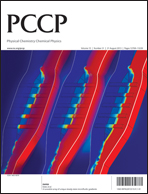First-principles studies on transport properties and contact effects of Cu(111)/ZnO-nanobelt(10![[1 with combining macron]](https://www.rsc.org/images/entities/char_0031_0304.gif) 0)/Cu(111) systems†
0)/Cu(111) systems†
Abstract
The transport properties of ZnO nanobelts along the 〈10![[1 with combining macron]](https://www.rsc.org/images/entities/char_0031_0304.gif) 0〉 non-polarized direction coupled with Cu electrodes were studied via non-equivalent Greens functions method and density functional theory formalism. The transport properties were greatly affected by interfacial spacing and nanobelt widths. The conductance decreased exponentially with the widths of the nanobelts. Ohmic behavior was found in narrow nanobelts, while rectifying characteristics were observed in wide nanobelts. In the case of narrow belts, the current–voltage characteristics were changed from ohmic type to rectifying characteristics as the interspace increased, corresponding to the contacts transforming from chemical to physical interactions. However, the conductance in the wider nanobelts declined exponentially as the interfacial distance increased. The change of metal induced gap states (MIGS) depends strongly on the interfacial distance but not significantly on the thickness of ZnO nanobelts. An n-type Schottky barrier between copper and ZnO nanobelts is induced by interfacial polarization effects. The Schottky barrier heights for the narrowest and widest nanobelts with equilibrium interfacial spacing were 0.37 eV and 0.44 eV, respectively, which is in good agreement with the experimental values. Additionally, the Schottky barrier heights increased almost linearly as the width of the nanobelts changed from 0.34 nm to 1.2 nm.
0〉 non-polarized direction coupled with Cu electrodes were studied via non-equivalent Greens functions method and density functional theory formalism. The transport properties were greatly affected by interfacial spacing and nanobelt widths. The conductance decreased exponentially with the widths of the nanobelts. Ohmic behavior was found in narrow nanobelts, while rectifying characteristics were observed in wide nanobelts. In the case of narrow belts, the current–voltage characteristics were changed from ohmic type to rectifying characteristics as the interspace increased, corresponding to the contacts transforming from chemical to physical interactions. However, the conductance in the wider nanobelts declined exponentially as the interfacial distance increased. The change of metal induced gap states (MIGS) depends strongly on the interfacial distance but not significantly on the thickness of ZnO nanobelts. An n-type Schottky barrier between copper and ZnO nanobelts is induced by interfacial polarization effects. The Schottky barrier heights for the narrowest and widest nanobelts with equilibrium interfacial spacing were 0.37 eV and 0.44 eV, respectively, which is in good agreement with the experimental values. Additionally, the Schottky barrier heights increased almost linearly as the width of the nanobelts changed from 0.34 nm to 1.2 nm.
![Graphical abstract: First-principles studies on transport properties and contact effects of Cu(111)/ZnO-nanobelt(10 [[1 with combining macron]] 0)/Cu(111) systems](/en/Image/Get?imageInfo.ImageType=GA&imageInfo.ImageIdentifier.ManuscriptID=C3CP50212K&imageInfo.ImageIdentifier.Year=2013)

 Please wait while we load your content...
Please wait while we load your content...
![[1 with combining macron]](https://www.rsc.org/images/entities/h2_char_0031_0304.gif) 0)/Cu(111) systems
0)/Cu(111) systems